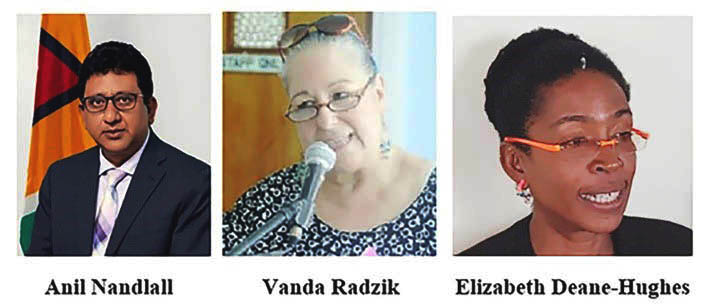Finding among other things that government has “substantial public, economic and pecuniary interests,” High Court Judge Priya Sewnarine-Beharry has allowed it to join the litigation challenging a decision made by the Environmental Protection Agency (EPA) to issue a permit to ExxonMobil for its Gas to Energy (GTE) project.
Exxon’s local affiliate—Esso Exploration and Production Guyana Limited (EEPGL)—which had argued that it, too, had interest to safeguard, has also been allowed to intervene in the proceedings.
Of the government, the Judge said in her ruling that given its “substantial public, economic and pecuniary interests” in the project, as well as its “benefit to the Guyanese public,” Attorney General Anil (AG) Nandlall SC had demonstrated sufficient interest on behalf of government to warrant it being heard in the matter.
 The Judge went on, “I find further that the AG, because of his unique position as the government’s principal legal advisor, may be privy to relevant facts and information (of which the Respondents/Applicants are in no position to speak and may be able offer a different, useful or practical perspective which this Court ought to take into consideration in determining the issue raised.”
The Judge went on, “I find further that the AG, because of his unique position as the government’s principal legal advisor, may be privy to relevant facts and information (of which the Respondents/Applicants are in no position to speak and may be able offer a different, useful or practical perspective which this Court ought to take into consideration in determining the issue raised.”
This of itself Justice Sewnarine-Beharry said, counterbalances any delay or prejudice caused to the Applicants.
Against that background, she said that the State ought to be given the opportunity to participate fully in the proceedings and place before the Court, for its consideration, evidence which it believes will vindicate its interest.
Regarding Esso, the Judge said that as the holder of the permit which is being impugned; and more so as the named operator of the GTE project, it “undoubtedly has an economic interest in this venture…a real, substantial and direct interest…in the subject matter of the proceedings.”
Justice Sewnarine-Beharry had initially set today to deliver her ruling, but it was instead rendered on Monday.
Arguments
A few weeks ago, Justice Sewnarine-Beharry heard submissions from the AG and Senior Counsel Edward Luckhoo for Esso who both argued that they ought to be able to intervene in the proceedings because of their interests therein.
With the project investment valued at a whopping US$1.7 billion, Nandlall had argued that the government has more than a mere interest as it had entered into an engineering, procurement and construction (EPC) contract for the construction of a 300 MW power plant to be constructed at Wales.
Because of what he described as the obvious interest and its involvement as a key player in the project, the AG said the government ought to be able to be heard in the litigation as “it has a substantial public, economic and pecuniary interest… and will be adversely affected by any judgment” in favour of the litigants.
Esso had argued that the orders sought in the fixed date application (FDA) are directed and intended to affect its rights and interests accruing or derived among itself, the Government of Guyana, and its co-venturers Hess Exploration Guyana Ltd and CNOOC Petroleum Guyana Limited.
Pursuant to the latter agreement Esso undertook five projects concerning petroleum exploration, development and production activities in the Stabroek Block. Additionally, Esso, Hess and CNOOC agreed with the government to transport and supply natural gas from some of the projects utilizing a 12” pipeline commencing in the Stabroek Block and along the floor of the seabed and onshore to an integrated plant for gas processing and power generation.
According to Esso US$206M was expended in design and construction works for the GTE and an additional US$762M is expected to complete and commission the pipeline element.
Against this background, Esso contended that it committed this substantial investment in reliance on the real and substantial rights accruing or derived from the permit issued by the EPA and the Petroleum Agreement.
Further it said that it could not be lawfully deprived of the rights accruing or derived from the permit without due process.
Activists Vanda Radzik and attorney Elizabeth Deane-Hughes (the Applicants) have mounted the legal challenge against the EPA, calling for the revocation of its decision to issue a permit to ExxonMobil for the development of a natural gas transport pipeline, materials offloading facility and natural gas liquids plant.
In objection to Esso and government being added as parties to the case, the Applicants contended that the issue before the Court is a very narrow one—that being whether the EPA acted in breach of Regulation 17(2)(c)(ii); and further, whether EPA complied with Regulations depends on whether it had in its possession the requisite documents before it issued the permit and for it to defend its actions and demonstrate that it acted lawfully.
Those issues Radzik and Deane-Hughes argued, had no bearing on Esso’s alleged expenditures; and was therefore unnecessary for it to be joined as a party as its intervention would unduly delay or prejudice the determination of the rights of the parties to the proceedings.
They said that the AG was not a necessary or proper party either, as he could not enable the Court to adjudicate the issue at hand and that government’s interest ought to be restricted only to making legal submissions.
Justice Sewnarine-Beharry in her ruling said that the High Court has jurisdiction to add parties to judicial review proceedings under Section 13 of the Judicial Review Act (JRA) and Parts 19 and 31 of the Civil Procedure Rules (CPR).
Section 13(1) of the Act provides, “Any person who has an interest in a decision which is the subject of an application for judicial review may apply to the Court to be made a party to the proceedings.”
Subsection (2) then goes on to state, “The Court may grant the application either unconditionally or subject to such terms and conditions as it thinks just or refuse the application.”
Meanwhile, Part 19:02 of the CPR provides, “The Court may at any stage of a proceeding on its own initiative or upon application, add… a party… on such terms that are just unless prejudice would result that could not be compensated for by costs or an adjournment.”
Part 31:01 further provides, “A person who is not a party to a proceeding may make an application for permission to intervene as an added party if the person claims, (a) an interest in subject matter of the proceeding; (b) that the person may be adversely affected by a judgement in the proceeding; or (c) that there exists between the person and one or more parties to the proceeding a question of law or fact in common with one or more of the questions in issue in the proceeding.”
The Judge noted in her ruling that upon an application under this Part, the Court needed to consider whether the intervention would unduly delay or prejudice the determination of the rights of the parties to the proceeding.
Justice Sewnarine-Beharry said that the Applicants had conceded that both Esso and the government have interest in the proceedings as required by the Rules.
“It is obvious that both Esso and the AG (government) would be adversely affected” if the orders sought by the Applicants were granted by this Court, the Judge said.
On this point she said that Esso is the holder of the Permit which is being impugned and also the named operator of the GTE project “and undoubtedly has an economic interest in this venture…a real, substantial and direct interest…in the subject matter of the proceedings.”
She went on, “moreover it has rights accrued or derived from the Permit and in all fairness ought to be heard and be able to fully defend its rights to the permit.”
Meanwhile, regarding the government she said, “given the State’s substantial public, economic and pecuniary interests in the GTE and its benefit to the Guyanese public, I find that the AG has demonstrated a sufficient interest to intervene in his capacity as guardian of the public interest.”
The Judge said she further found that the AG, because of his unique position as government’s principal legal advisor, may be privy to relevant facts and information on which the Applicants are in no position to speak “and may be able offer a different, useful or practical perspective” which may have to be considered in determining the issue raised.
“I find that this of itself counterbalances any delay or prejudice caused to the Applicants. I therefore find that the AG ought to be given the opportunity to participate fully in the proceedings and place before the Court, for its consideration, evidence which he believes will vindicate the State’s interest,” Justice Sewnarine-Beharry said.
Background
The contention of Radzik and Deane-Hughes in their FDA is that the permit was issued in breach of regulation 17(2) of the Environmental Protection (Authorisation) Regulation.
The regulation they noted, states that a developer must provide proof that it “either owns the facility or has a lease or other agreement with the landowner or occupier to enable the applicant to conduct the activity on the facility or has the legal right of way to conduct the activity without the consent of the landowner or occupier.”
Several Guyanese and not ExxonMobil own several tracts of land under transport and lease along the proposed pipeline route, and it is on this basis that Radzik and Deane-Hughes through their attorney Melinda Janki, are asking for the permit to be revoked.
In a letter on behalf of her clients to Executive Director of the EPA Kemraj Parsram, Janki had said it was incontrovertible that the route for the proposed pipeline will run on land that is not owned by EEPGL, not held by EEPGL under any lease, and not subject to an agreement which would allow EEPGL to construct the onshore pipeline along the route.
“It follows logically and simply that the permit was issued in breach of regulation 17. The agency did not have the legal power to authorise EEPGL to construct a pipeline in the absence of the proof required by regulation 17,” she had said in her letter.
The government, through the Attorney General, has said, however, that it “acquired the lands…and has entered into agreements for compensation with most of the affected property owners.”
In their fixed date application seeking an order of certiorari quashing EPA’s decision, Radzik and Deane-Hughes said that it was not only unlawful, but, among other things, “unreasonable” and exercised beyond the agency’s powers.
Against this background they want the court to specifically declare that the EPA acted in breach of regulations and for the permit to be rendered null, void and of no legal effect.
They have said that they are not opposed to the gas to energy project, but that the process must be in strict compliance with the law; stressing that “the only lawful path” available to EPA is for Esso to submit proof that it either owns or has a lease or other agreement with the landowners or occupiers of the lands which will be affected by the project, prior to the issue of the environmental permit.





